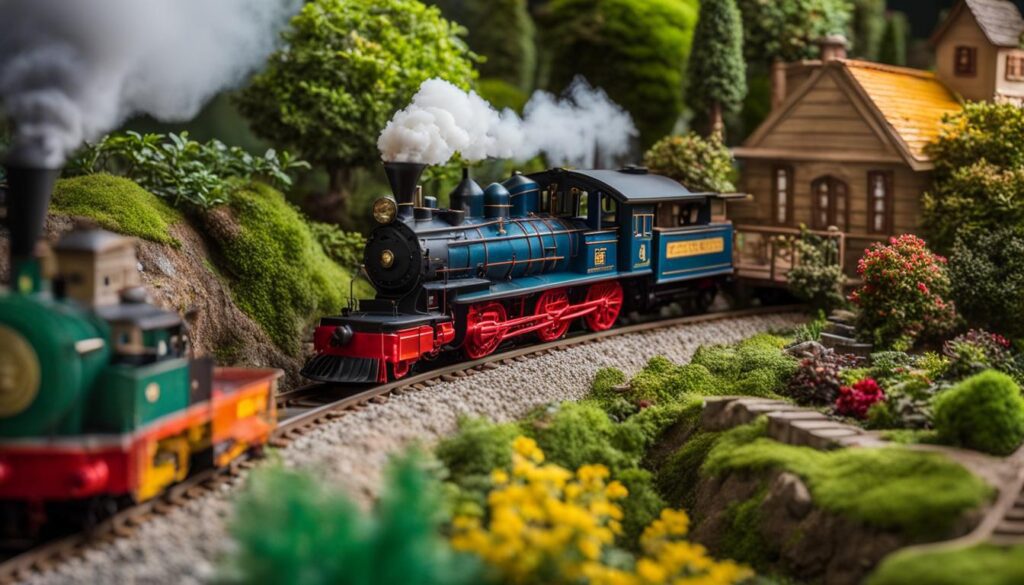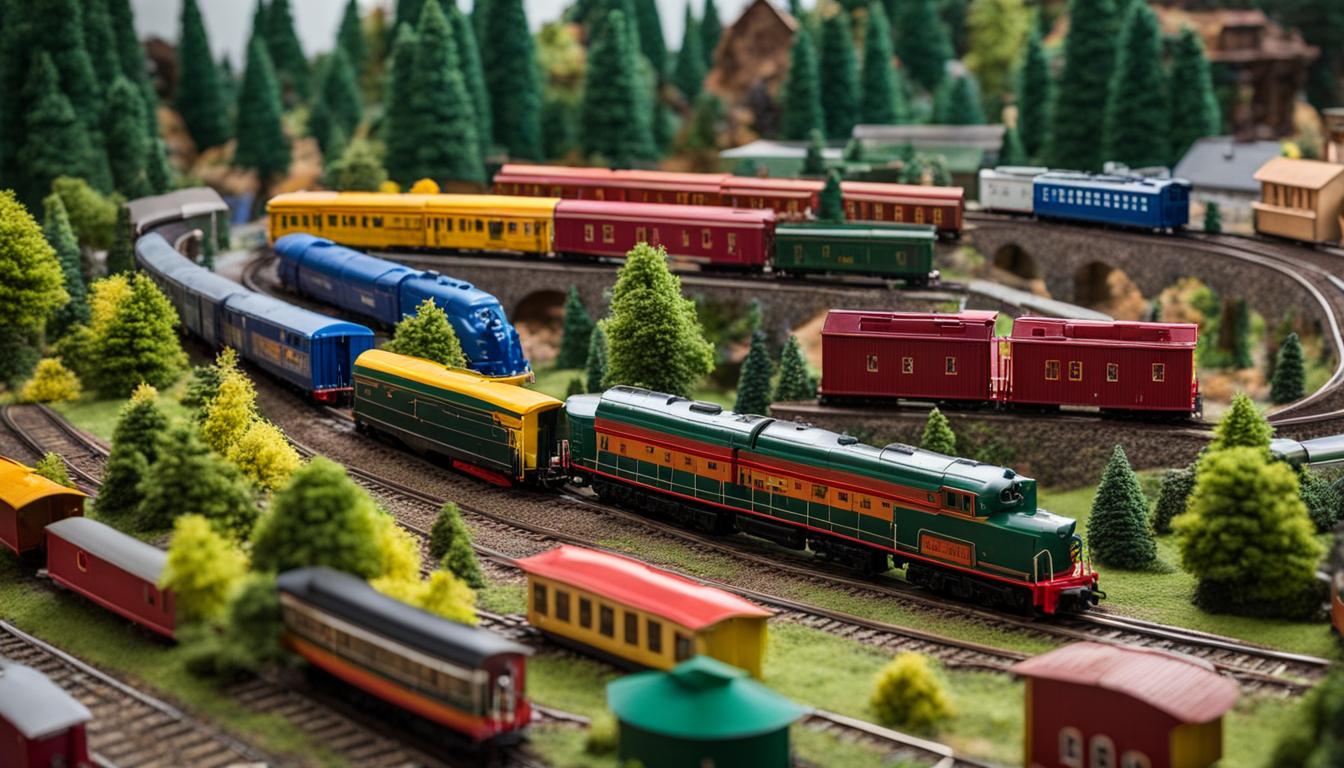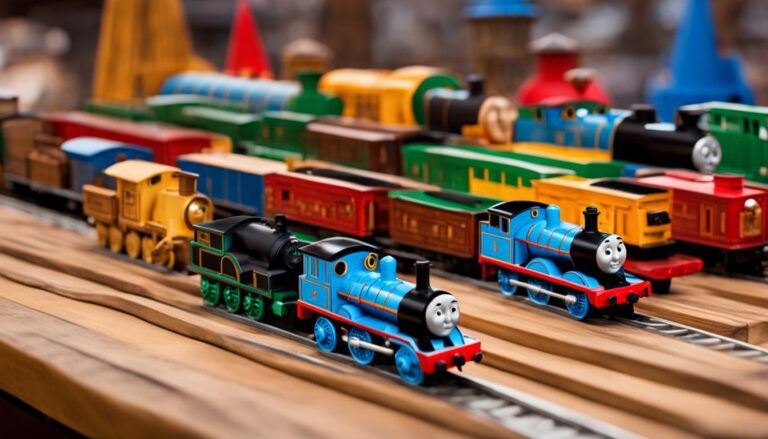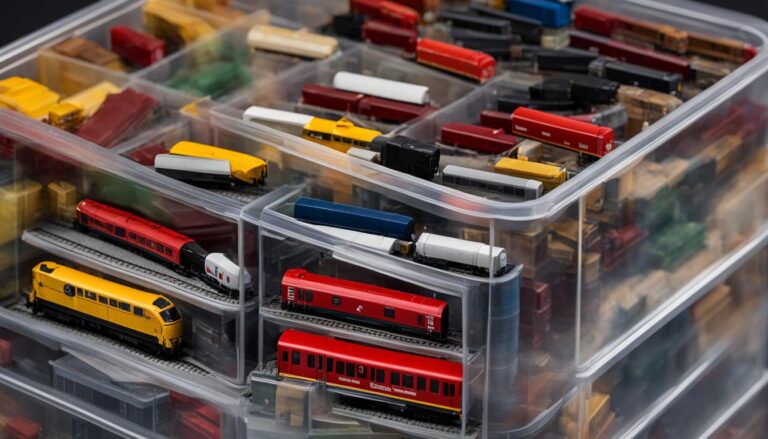Different Model Train Scales: What You Need to Know
We’re glad you found our guide to the different scales of model trains. No matter how experienced or new a modeler is, they need to know about scales in order to make the best plan. This piece gives you a look at the HO, N, O, G, S, and Z scales that are common in North America.
Model train scales are numbers that show how big or small a model is compared to a real thing. You can be sure that your models and accessories will work with each other if you choose a specific size. The size tells you how much smaller the model is than the real thing. At 1:87, the HO scale means that things are 87 times smaller than they really are.
Key Takeaways:
- Model train scales are numbers that show how big or small a model is compared to a real thing.
- Most people in North America like to build model trains in the HO, N, O, and G scales.
- The HO scale is the most common. The N, O, and G sizes are next in line.
- Even though S scale and Z scale aren’t used as much, they still have their own groups.
- When selecting a scale, think about the models and accessories that are available, as well as the layout room you have.
HO Scale: The Most Popular Model Train Scale
When it comes to model trains, HO scale is the best. Fans in the US and Canada love it. For every 1:87.1 scale model, the real thing is 87.1 times bigger than the HO scale model. This scale is a favorite among artists and collectors because it has the right amount of size and detail.
One of the reasons HO scale is so popular is the wide variety of models available. From rolling stock to locomotives and buildings, HO scale modelers have an extensive range of options to choose from. The scale’s fine detail and realism make it ideal for creating highly realistic layouts and scenes. Whether you’re a beginner or an experienced modeler, HO scale provides endless opportunities for customization and creativity.
You can also do a lot of different things with HO size. HO scale works well for both simple and complicated track ideas, like basic ovals. Layouts, which are usually on flat plywood, make it easy to plan and build. Because the scale is so popular, there is a lively group of HO scale modelers who are always willing to help each other.
“HO scale offers the perfect combination of size and detail. It allows me to create realistic scenes while still having enough space to showcase my collection.” – John, HO scale modeler
HO Scale Modelers: The Heart of the Hobby
Fans of HO size model trains are called “HO scale modelers.” These determined athletes push the sport’s limits. Sharing information, tips, and tricks helps modelers improve.
For people who work with HO scale models, building a train track isn’t just about making a small world come to life. There is a lot of skill and attention to detail that goes into every HO size project. HO scale modelers bring their layouts to life with great care, from making structures from scratch to weathering rolling stock.
Join the HO scale world through online forums, social groups, and local clubs. Seek advice, find inspiration, or share your latest project—welcome awaits in the HO scale community.
Start with HO size if you want to get into model trains. A lot of people like it because it’s easy to use and comes with a lot of different types and accessories. You can let your imagination run wild as you build your own HO scale kingdom by joining the HO scale community.
N Scale: Ideal for Smaller Spaces
For those with limited space or a taste for intricate layouts, choose N scale in model trains. With a ratio of 1:160, N scale models, half the size of HO, allow for detailed and realistic scenes. This makes N scale a favorite among hobbyists who relish crafting lifelike landscapes.
One benefit of N scale is that it can be used in many ways. Because they are small, N scale models can be used in places like apartments and small rooms. Thus, it’s an excellent option for model train fans who don’t have a lot of room to set up their tracks. Even though it’s smaller, N scale still has a lot of models and items that can be used to make layouts that are both interesting and fun to look at.
A lively group grows in the world of N scale. Modelers, whether they are experienced or new to the hobby, are always pushing the limits to get more and more detailed trains, rolling stock, and scenery. People who build N scale models are happy to be a part of the fun and challenging process of making small worlds come to life.
Table: Comparison of Model Train Scales
| Scale | Ratio | Advantages | Disadvantages |
|---|---|---|---|
| N Scale | 1:160 | – Ideal for smaller spaces – Wide range of models and accessories – Realistic detail | – Can be more challenging to work with due to small size |
| HO Scale | 1:87.1 | – Most popular scale in North America – Wider variety of models available – Versatile for both simple displays and complex layouts | – Requires more space compared to N scale |
| O Scale | 1:48 | – Nostalgic charm – Suitable for large, detailed layouts – Can create scale models or toy trains | – Requires significant space |
| G Scale | Varies (1:32, 1:24, 1:22.5) | – Perfect for outdoor garden railways – Incorporates natural elements like plants and water features – Larger size for more lifelike scenes | – Limited availability compared to other scales |
So, whether you want to make a small world in a small area or push yourself with lots of small details, N scale is a fun and rewarding way to do it. N scale modelers can make their own layouts and bring their ideas to life because the scale is small and there are many models and extras to choose from. Enjoy the beauty of N scale and open up a world of options for your model train trip.
O Scale: A Classic and Popular Choice
O scale, with a ratio of 1:48, is a classic and popular model train scale that has been enjoyed by enthusiasts for many years. It offers a unique combination of nostalgia and versatility, making it a favorite among collectors and modelers alike. O scale trains, with their notable size and intricate details, excel at presenting breathtaking scenes and instilling a grand ambiance.
One great thing about O scale is that it has a long past, especially with companies like Lionel. Lionel trains are well-known in the world of model trains, and O scale is often linked to their fine workmanship and complex designs. Aside from Lionel, there are many other companies that make O scale trains, giving modelers a lot of choices.
If you have a lot of room, O scale lets you make models that are both big and realistic. Because the trains and accessories are bigger, you can add more details and make the scenery more interesting by adding mountains, rivers, and caves. The attraction grows when you consider On30, a narrow-gauge version that combines the charm of narrow railways with the grandeur of larger O scale models.
| Scale | Ratio | Key Features |
|---|---|---|
| O Scale | 1:48 | Larger size, intricate detail, rich history |
| HO Scale | 1:87.1 | Wide variety of models, fine detail, versatile |
| N Scale | 1:160 | Ideal for smaller spaces, intricate scenes |
| G Scale | Varies (e.g., 1:32, 1:24, 1:22.5) | Outdoor display, incorporates natural elements |
O scale is intriguing and memorable for collectors and hobbyists. Its increased size and attention to detail make it ideal for constructing breathtaking landscapes and immersive model train layouts. This scale allows for infinite inventiveness and fun, whether you’re reliving Lionel trains golden age or trying out other O scale manufacturers.
G Scale: The Garden Railway Option
G scale model trains are ideal for outdoor enthusiasts. These models are larger than O scale models and can be turned into beautiful garden railroads with a ratio of 1:32 to 1:22.5. G scale trains are popular among outdoor model train enthusiasts because they have more detail and realistic scenes.
G scale lets you combine rail passion with nature. These larger trains allow you to add actual plants, water fountains, and other natural aspects to your model train layout. Imagine a small train moving through a lovely garden full with flowers and trees. G scale’s stunning visuals can transport you to another dimension.
“G scale trains in an outdoor garden railway setting provide a unique and immersive experience. The combination of model railroading and natural scenery creates a captivating and realistic atmosphere that appeals to enthusiasts of all ages.”
G size allows outdoor setup versatility in large yards or small patios. Heftier trains and tracks are easier to handle and weatherproof. G scale garden railway models are durable and will provide years of enjoyment.
The Advantages of G Scale:
- Perfect for outdoor displays: G scale trains let you build beautiful garden railways.
- The bigger size of G scale models makes it possible to add genuine plants, water features, and other natural components to your layout.
- G scale trains are weatherproof and durable, ensuring years of amusement.
- G size works for any outdoor location, from big backyards to modest patios.
As you plan your model train layout, consider the unique advantages of G scale. It offers a truly immersive experience, combining the joy of model railroading with the beauty of nature. Whether you choose to create a grand garden railway or a small-scale outdoor display, G scale will bring your vision to life in a captivating and realistic way.
| G Scale | O Scale | N Scale | HO Scale |
|---|---|---|---|
| 1:32 to 1:22.5 | 1:48 | 1:160 | 1:87.1 |
| Perfect for outdoor garden railways | Offers a nostalgic charm | Ideal for smaller spaces | Most popular scale in North America |
| Allows for incorporation of natural elements | Can be used for toy trains or true scale models | Wide range of models and accessories available | Offers fine detail and wide variety of models |


S Scale: Realistic Two-Rail Track System
S scale model trains are known for their realistic two-rail track arrangement. These scale models are 64 times smaller than real life and accurately depict trains and scenery. American Flyer Trains popularized S scale, and aficionados still love its realism and difficulty.
“S scale allows me to delve deep into the art of model train building. The two-rail track system provides a more realistic look, and it’s a pleasure to craft and customize my own models using parts and materials.”
American Flyer Trains dominates the options available in S scale, offering a wide range of locomotives, rolling stock, and accessories. However, other manufacturers have also recognized the demand for this scale and have started offering modern options to cater to the growing community of S scale modelers.
S scale is particularly attractive to those who enjoy building their models from scratch and embrace the challenge of improvisation. By combining their craftsmanship with the realistic two-rail track system, S scale modelers can create stunning layouts with intricate details and lifelike scenery.
If you’re a model train fanatic with a lot of experience or a beginner looking for a new scale to try, S scale is a great way to get into the art of realistic model railroading. You can enjoy the pleasure of making your own models and layouts that capture the real beauty of railroads with American Flyer Trains at the top of this scale’s offerings.
Z Scale: The Smallest Practical Model Railroading Scale
In model train scales, Z scale claims the title as the tiniest commercially accessible choice. At a ratio of 1:220, Z scale models shrink a remarkable 220 times from their real-life counterparts. Though Z scale’s train and accessory selection may be modest, a devoted following among model railroaders persists.
Z scale displays grace shows, often nestled in suitcases or everyday items, accentuating their diminutive stature. Despite its small scale, Z scale models offer a surprising amount of detail and craftsmanship, making them a delight for enthusiasts who appreciate the intricacies of miniature railroading.
So why pick Z scale? Because it’s small, realistic and compact layouts can be made. This makes it a great choice for modelers who don’t have a lot of room or who want to show off their talent in a small space. Working with such small models can be difficult, but it can also be fun for people who like the accuracy and skill needed to make realistic scenes.
While Z scale may not be as widely popular as HO or N scale, its uniqueness and charm make it a standout choice for those who appreciate the artistry of small-scale model railroading.


Summary:
- Z scale is the smallest commercially available model train scale, with a ratio of 1:220.
- Despite limited selection, Z scale models offer impressive detail and craftsmanship.
- Z scale layouts are often displayed in unique ways to highlight their small size.
- Choosing Z scale allows for realistic and compact layouts in smaller spaces.
| Scale | Ratio | Description |
|---|---|---|
| Z Scale | 1:220 | The smallest commercially available model train scale, offering incredibly tiny models and layouts. |
| HO Scale | 1:87.1 | The most popular model train scale in North America, known for its wide variety of models and accessories. |
| N Scale | 1:160 | A smaller scale than HO, ideal for modelers who want to create elaborate layouts in limited spaces. |
| O Scale | 1:48 | A larger scale often used for toy trains, but also suitable for creating scale models with intricate detail. |
| G Scale | Varies (e.g., 1:32, 1:24, 1:22.5) | A larger scale primarily used in outdoor garden railways, perfect for combining train models with natural elements. |
Conclusion
Model train scales come in a variety of sizes, each offering unique advantages and options for modelers. From the most popular HO scale to the smaller N scale, the classic O scale, the garden-friendly G scale, the realistic S scale, and the tiny Z scale, there is a scale to suit every preference and vision.
When choosing a scale, consider the available models and accessories, as well as the space you have for your layout. If you crave fine detail and versatility, HO scale might be the best choice for you. For those with limited space, N scale offers the opportunity to create intricate layouts. O scale, with its rich history and nostalgic appeal, is a favorite among collectors. G scale provides the canvas for outdoor displays, combining trains and gardens. S scale offers a realistic two-rail track system, while Z scale challenges with its tiny size and surprising detail.
No matter which scale you choose, remember that it is your personal preference and vision that matters most. Explore the different model train scales, immerse yourself in the communities, and let your creativity guide you in building the model train setup of your dreams.
FAQ
What are model train scales?
Model train scales are ratios or percentages used to measure models in proportion to their real-life counterparts.
What are the most popular model train scales in North America?
The most popular model train scales in North America are HO, N, O, and G.
What is the ratio for HO scale?
The ratio for HO scale is 1:87.1, which means objects in this scale are 87.1 times smaller than their real-life counterparts.
Why is HO scale popular?
HO scale is popular because it offers a wide variety of models, fine detail, and a wide range of accessories.
What is the ratio for N scale?
The ratio for N scale is 1:160, making it roughly half the size of HO scale.
Why is N scale ideal for smaller spaces?
N scale is popular among modelers who want to build more elaborate layouts in smaller spaces or have limited room for their models.
What is the ratio for O scale?
The ratio for O scale is 1:48, and it is often used for toy trains but can also be used for true scale models.
Why is O scale popular for larger spaces?
O scale is popular among modelers with large spaces who want to create detailed and majestic scenes, especially when using a narrow-gauge version called On30.
What is the ratio for G scale?
The ratios for G scale can vary, but they are larger than O scale and can include ratios such as 1:32, 1:24, and 1:22.5.
Why is G scale used for outdoor garden railways?
G scale trains are often used in outdoor garden railways, where hobbyists combine their love of trains with beautiful gardens and real scenic elements.
What is the ratio for S scale?
The ratio for S scale is 1:64, and it is known for using a more realistic-looking two-rail track system.
Why is S scale popular among modelers?
S scale is popular among modelers who enjoy building their own models from scratch and improvising using parts, providing a unique challenge and customization opportunities.
What is the ratio for Z scale?
The ratio for Z scale is 1:220, making it the smallest commercially available model train scale.
Why is Z scale unique?
Despite its small scale, Z scale models offer a surprising amount of detail and can be enjoyed by dedicated model railroaders. They are often displayed in suitcases or other everyday objects to highlight their tiny size.







